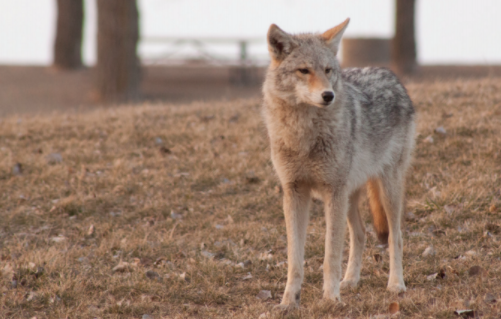Coexisting with Coyotes

The RM tends to get several calls a year with a variety of questions regarding coyotes. It is important to understand how to coexist with coyotes as the vast environment of our Municipality seems to be a place that they tend to frequent. We chatted with Dr. Heather Hinam for her expertise and advice for residents.
Hinam is the owner of Second Nature, Adventures in Discovery. She combines a Ph.D. in Conservation Ecology with more than 20 years experience as a nature and heritage interpreter and award-winning artist and photographer.
Q: What is the role coyotes play in the ecosystem?
A: Like all top predators, coyotes are a vital part of the ecosystem. They’re opportunistic and omnivores, so they will eat just about anything. I once saw a video of a coyote up in a tree, eating apples. Mice and voles, however, make up a large part of their diet, so they are great to have around for rodent control.
Q: What can residents do to coexist with coyotes?
A: The important thing to remember is to clean up any potential sources of food. That means cleaning up any garbage or fruit that may have fallen off of trees in your yard. Keeping the bird feeder area clean of excess seed keeps mice and rabbits away, reducing the draw for coyotes. Don’t leave food out for your pets and if you have chickens or rabbits or any other animal, be sure they are penned up with heavy mesh wire.
Q: How can people protect their pets from coyotes? Should this be a particular concern?
A: While coyotes are not overly interested in people, they can be interested in your dogs and cats. Keep cats indoors, unless they are leashed and you are supervising them. This is not only safer for the cat, but also better for the birds in your area. Dogs should also be leashed at all times when you’re out walking. If you don’t have a fenced yard, keep an eye on your dog when you let them out and never let them roam.
Q: What should people do if they encounter a coyote?
A: Encountering a coyote can be really neat, but also scary. If you have a dog with you, pick it up if you can, otherwise bring it in close. Never turn your back to the coyote. If it’s not during the breeding season (April-June) it’s best to ‘haze’ the coyote to remind it that people are scary. Stand up tall and make yourself look big. Yell ‘go away’ or other words loudly, but don’t scream. Be as assertive and scary as possible as you slowly back away. As much as it might be tempting to want to watch these beautiful animals, you don’t want to let them get used to people.
Q: Can you share an encounter you may have had with a coyote? What was it like?
A: I’ve met several coyotes over the years. Most of the time, it’s just a fleeting glimpse before they bound away. Once, while doing field work, I accidentally got too close to a pack of coyotes that had likely just killed something. Several of them howled at me from all sides and one came out in front of me. I got the message that they wanted me to leave and got out of there immediately. They let me know without incident. It was a bit scary, but they were mostly just giving me a warning. It’s important to be aware of your surroundings when you’re out in nature and the better you understand the animals you might encounter, the less afraid you’ll be, and the better you will react if you meet one.
Helpful links with further information about Coyotes:
Coexistence of Pets and Wildlife
Living with Wildlife in Manitoba
Coexisting with Coyotes
